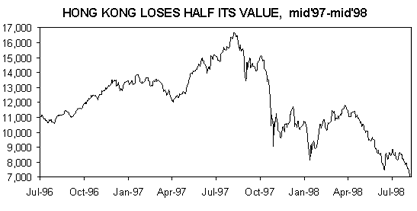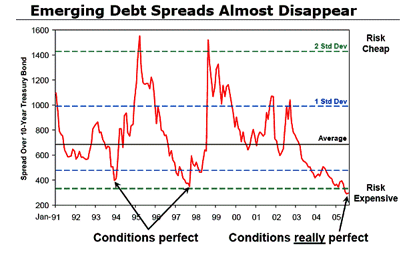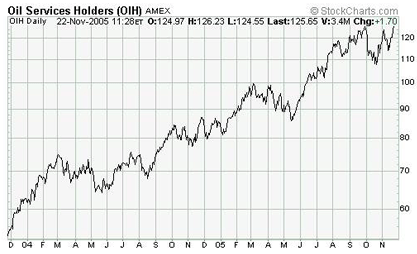| Home | About Us | Resources | Archive | Free Reports | Market Window |
My Big Lessons From Hong KongBy
Friday, November 25, 2005
It was late 1993, and I was making way too much money... I was a broker specializing in international stocks and bonds...and my customers were making a fortune. It wasn’t any special skills that I had. It was just what we were buying... Officially, we could buy stocks and bonds around the world. But the reality was, it was all about China. Since there was no great way to play China directly, it was all about Hong Kong and the surrounding emerging markets. Hong Kong’s Dow... the “Hang Seng Index”, rose over 100% in 1993. But it was filled with big, boring stocks. If you took a little risk with smaller stocks, you could do even better. And our customers did. By the end of 1993, our customers were no longer afraid. Business was fantastic. It was too easy... China was going to grow indefinitely, and we were going to grow rich indefinitely by investing through Hong Kong. Every day, this belief was reinforced. There were only five down days in the Hong Kong stock market for the entire month of December that year. The Hong Kong market just always went up. Until it didn’t. Things started to go wrong fast. The Hang Seng Index lost 16% of its value in 8 days in early January.
We got a recovery in February... the Hang Seng Index climbed back near the old highs. That fooled us into thinking the end wasn’t here. But it was. And then March came... It was awful. I wanted to crawl under my desk. March of 1994 was the opposite of December 1993. The Hang Seng Index went down on 70% of the trading days in March. I didn’t even want to pick up the phone and talk to customers. That’s when I learned thatyou’ve always got to cut your losses. That you are not as smart as you think you are. And that markets can go down farther than you can possibly imagine. The movie played itself out again a few years later. Hong Kong had recovered back to new highs in three years time, and by mid-1997 it was off to the races again. Everyone forgot about risk again. And then another shellacking came:
[Editor's note: Steve probably wouldn't mention this, but I know that just before the Hong Kong bear market of 1997-1998, Sjuggerud and Stansberry were the portfolio managers of China Business and Investment, a high end financial advisory for institutions. In September of 1997, two weeks before the crash began, they recommended selling every single Hong Kong stock on their recommended list. The decision to get out was made solely on the basis of trailing stop discipline. To further protect subscribers, they also recommended buying puts on Telebras, the huge phone company in Brazil, which was the single largest emerging market stock in the world at the time. Those puts made over 400% in October of 1997 as emerging markets melted down. -- B.H.] The Hang Seng Index lost half its value in a year. Hong Kong stocks were obliterated twice in less than five years. What are the big lessons here? There are at least two:
The chart below, from Jeremy Grantham, tells me all I need to know.
Chart source: www.gmo.com This chart shows at what interest rate emerging market countries like Brazil and Russia can borrow money. Right now, emerging market countries can borrow at just 2.4 percentage points over U.S. Treasury bonds... a level not seen since the two shellackings I described above. In late 1993, as the chart shows, everyone believed things couldn’t go wrong – that conditions were “perfect” in emerging markets like Hong Kong. Well, it turned out they weren’t. Then in mid-1997, everyone once again believed that things couldn’t go wrong in emerging markets like Hong Kong. Once again, it turns out things can go wrong...quickly. The lesson of Grantham’s interest rate chart is this: When investors forget about risk... when they are willing to lend money to risky emerging markets at extremely low interest rates (like 1994 and 1997), they lose their shirts soon after. Right now, U.S. Treasury bonds are currently paying around 4.4% interest. Emerging market countries can borrow at a very low 6.8% interest. It’s crazy, you’ve got to admit. Everyone thinks conditions are “really perfect” in emerging markets... more perfect than ever. I say that history will repeat itself. I’m an aggressive investor when the time is right. But now – particularly in emerging markets – the time is right to play it safe. Since the 1993 boom in Hong Kong, where I was making a fortune (for me), and the subsequent bust (where I wanted to hide under my desk), I’ve seen a lot of bull and bear markets come and go around the world. I’m speaking to you from experience. I have no agenda, of course, except to help you be a smarter investor. And my message is: Now is not the time to play in emerging market stocks in particular, or risky investments in general. If you must play, you absolutely must prevent the “catastrophic loss,” by using a trailing stop. Having lived through it, I can’t stress enough that riskier investments like emerging markets usually get obliterated when conditions are like this. You really ought to pay attention, no matter what. Good investing, Steve Market NotesOIL SERIVCE STOCKS ON THE REBOUND Despite a 20% correction in crude oil over the past few months, oil service stocks like Halliburton (HAL) have climbed back to approach their yearly highs. As investment banker Matthew Simmons puts it, “energy research and development needs to explode” to meet the world’s crude oil needs. If the world follows Simmons’ advice, it means more money flowing into the companies who deal in drilling rigs, pipeline capacity, oil tankers, refining capacity, and so on. A proxy for this sector is the Oil Service HLDRS Trust (OIH). This exchange-traded fund contains oil infrastructure stocks like the infamous Halliburton and drilling specialist Transocean (RIG). A two-year chart of the oil service bull market:
|
Recent Articles
|





